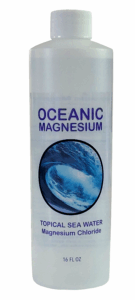Magnesium is an essential mineral involved in over 300 enzymatic reactions in the human body, affecting nearly every physiological system. Despite its importance, magnesium deficiency is widespread due to agricultural depletion, dietary imbalances, and environmental stressors. Oceanic Magnesium—magnesium chloride derived from seawater—is one of the most bioavailable and therapeutically effective forms for restoring magnesium levels, especially through transdermal absorption.
- The Cellular Importance of Magnesium
Magnesium plays a pivotal role in cellular metabolism, neuromuscular transmission, energy production, DNA and RNA synthesis, and electrolyte regulation. It is required for adenosine triphosphate (ATP) activation—the body’s primary energy currency (de Baaij et al., 2015). Over 3,700 magnesium binding sites have been identified across cellular proteins (Romani, 2013), demonstrating its universal necessity for biological function.
Every organ system requires magnesium, particularly the nervous, cardiovascular, musculoskeletal, and endocrine systems. Magnesium acts as a physiological calcium antagonist, preventing pathological calcification of tissues, maintaining the electrical stability of cells, and regulating smooth muscle tone (Nielsen, 2018).
- Modern Causes of Magnesium Deficiency
Despite its abundance in seawater and once in fertile soils, modern agriculture has led to a severe decline in dietary magnesium intake. Industrial farming practices prioritize macronutrients—nitrogen, phosphorus, and potassium—while neglecting magnesium replenishment in the soil (Maguire & Cowan, 2002). Consequently, even whole foods are now significantly lower in magnesium content than they were a century ago.
In addition to agricultural depletion, modern stressors accelerate magnesium loss. Emotional stress, processed diets, and environmental toxins increase urinary excretion of magnesium (Seelig, 1994). The following factors are known to deplete or block magnesium absorption:
-
- Alcohol and caffeine
- Sugar and refined carbohydrates
- Calcium-dominant or sodium-rich diets
- Diuretics and many prescription medications
- Excessive perspiration from exercise or heat
- Environmental pollutants (e.g., fluoride, heavy metals)
These cumulative stressors create what scientists call a “magnesium burn rate”—the rate at which magnesium is lost faster than it can be replaced (Dean, 2014).
- Physiological Consequences of Magnesium Deficiency
Low magnesium status has been correlated with a broad range of health disturbances, including but not limited to:
| System | Symptoms & Conditions Associated with Deficiency | Supporting Evidence |
| Neurological | Anxiety, depression, insomnia, migraines, hyperactivity, poor memory | Eby & Eby, 2006; Murck, 2002 |
| Cardiovascular | Arrhythmias, hypertension, atherosclerosis, coronary artery disease | Barbagallo & Dominguez, 2010 |
| Musculoskeletal | Muscle cramps, spasms, joint pain, fibromyalgia, osteoporosis | Rude et al., 2009 |
| Endocrine & Metabolic | Insulin resistance, metabolic syndrome, diabetes | Rodríguez-Morán & Guerrero-Romero, 2003 |
| Immune & Inflammatory | Chronic fatigue, autoimmune susceptibility, inflammation | Mazur et al., 2007 |
| Renal & Hepatic | Impaired detoxification, kidney stones, gallbladder issues | Gröber et al., 2015 |
Magnesium also plays a crucial role in activating the parasympathetic nervous system—the body’s relaxation response. Without adequate magnesium, stress hormones remain elevated, leading to systemic inflammation and cellular overexcitation (Galland, 2010).
- The Calcium-Magnesium Balance
Calcium and magnesium maintain a delicate biochemical balance. Calcium excites muscles and nerves, while magnesium calms them. Excess calcium intake without sufficient magnesium can lead to calcification of soft tissues, including arteries and joints—manifesting as arthritis, arteriosclerosis, or kidney stones (Seelig & Rosanoff, 2003).
Maintaining a healthy magnesium-to-calcium ratio (ideally around 1:1 or 1:2) is vital for preventing these degenerative conditions.
- Transdermal Absorption: Why Oceanic Magnesium Works So Well
Recent studies show that magnesium can be effectively absorbed through the skin (Waring, 2013; Kass et al., 2017). Transdermal delivery bypasses the gastrointestinal tract, which can limit magnesium uptake due to poor absorption or laxative effects of oral forms.
Magnesium chloride, especially when derived from oceanic or ancient seabed sources, is highly soluble and penetrates the skin efficiently. Once absorbed, it increases intracellular magnesium concentration and promotes relaxation of muscles and nerves.
In addition, transdermal application:
-
- Supports muscle recovery and joint flexibility
- Reduces stress and promotes restful sleep
- Enhances cellular detoxification
- Restores skin hydration and barrier integrity
A simple Oceanic Magnesium bath or foot soak (using 1–2 cups of magnesium chloride flakes in warm water for 20–30 minutes) can provide measurable increases in serum magnesium and produce calming, restorative effects (Kass et al., 2017).
- The Oceanic Advantage
Oceanic Magnesium sources—such as those harvested from pristine seabeds or the ancient Zechstein Sea—contain a unique balance of trace minerals that enhance magnesium’s therapeutic profile. These forms are free from industrial contaminants and are highly bioavailable.
When used topically, Oceanic Magnesium offers the same cellular nourishment once obtained naturally through contact with mineral-rich seawater, a practice that ancient civilizations recognized for its restorative power.
- Conclusion
Magnesium chloride, especially in its oceanic form, represents one of the most effective and natural ways to restore magnesium balance in the modern body. Given that nearly every physiological process depends on this mineral, addressing magnesium deficiency is not just a wellness trend—it’s a foundational act of biological repair.
In essence, modern stress depletes magnesium; oceanic magnesium restores it. Through the skin, through the cells, through the core of your being—it calms, heals, and rebalances the body to its natural rhythm.
References
- Barbagallo, M., & Dominguez, L. J. (2010). Magnesium and aging. Current Pharmaceutical Design, 16(7), 832–839.
- Dean, C. (2014). The Magnesium Miracle (2nd ed.). Ballantine Books.
- de Baaij, J. H., Hoenderop, J. G., & Bindels, R. J. (2015). Magnesium in man: implications for health and disease. Physiological Reviews, 95(1), 1–46.
- Eby, G. A., & Eby, K. L. (2006). Rapid recovery from major depression using magnesium treatment. Medical Hypotheses, 67(2), 362–370.
- Galland, L. (2010). Magnesium deficiency and stress: a vicious circle. Biological Trace Element Research, 133(1), 1–9.
- Gröber, U., Schmidt, J., & Kisters, K. (2015). Magnesium in prevention and therapy. Nutrients, 7(9), 8199–8226.
- Kass, L., Rosanoff, A., Tanner, A., Sullivan, K., & McKee, D. (2017). Effect of transdermal magnesium chloride on serum and urinary magnesium levels in humans. PLOS ONE, 12(8), e0180067.
- Maguire, M. E., & Cowan, J. A. (2002). Magnesium chemistry and biochemistry. BioMetals, 15(3), 203–210.
- Mazur, A., Maier, J. A., Rock, E., Gueux, E., Nowacki, W., & Rayssiguier, Y. (2007). Magnesium and the inflammatory response. Pharmacological Reports, 59(S1), 60–66.
- Murck, H. (2002). Magnesium and affective disorders. Nervenarzt, 73(8), 730–736.
- Nielsen, F. H. (2018). Magnesium deficiency and increased inflammation: current perspectives. Journal of Inflammation Research, 11, 25–34.
- Richards, Herb Roi (2024). Oceanic Magnesium: How to Use Topical Sea Water Magnesium for Health Benefits
- Rodríguez-Morán, M., & Guerrero-Romero, F. (2003). Oral magnesium supplementation improves insulin sensitivity and metabolic control in type 2 diabetic subjects. Diabetes Care, 26(4), 1147–1152.
- Romani, A. M. (2013). Magnesium in health and disease. Metabolism, 62(4), 607–613.
- Rude, R. K., Gruber, H. E., Wei, L. Y., Frausto, A., & Mills, B. G. (2009). Magnesium deficiency: effect on bone and mineral metabolism in the rat. Calcified Tissue International, 72(1), 32–41.
- Seelig, M. S. (1994). Consequences of magnesium deficiency on the enhancement of stress reactions; preventive and therapeutic implications (a review). Journal of the American College of Nutrition, 13(5), 429–446.
- Seelig, M. S., & Rosanoff, A. (2003). The Magnesium Factor. Avery.
- Waring, R. H. (2013). Magnesium deficiency: pathophysiology and management through transdermal magnesium therapy. International Journal of Nutritional Science, 3(1), 1–8.


Leave a Reply